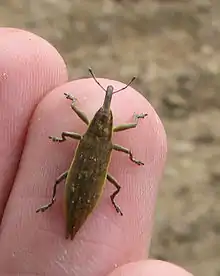Lixinae
Lixinae is a subfamily of true weevils,[1] included in the Molytinae in many older treatments. They are mainly root feeders, although some develop in flower buds or stems. Several species are used in biological control of invasive weeds, namely knapweeds (Centaurea).
| Lixinae | |
|---|---|
 | |
| Lixus iridis | |
| Scientific classification | |
| Kingdom: | |
| Phylum: | |
| Class: | |
| Order: | |
| Suborder: | |
| Infraorder: | |
| Superfamily: | |
| Family: | |
| Subfamily: | Lixinae |
| Tribes | |
|
Cleonini | |
Characteristics include tarsal claws that are fused at the base, and labial palps are short and telescoping. The body is elongate shape, as for some other weevils. Each tibia bears an uncus (small hook) on its distal end. The rostrum is forwardly directed.
Genesis
Bearing in mind modern geographical distribution of Lixinae and its feeding links, it is considered to be that this subfamily appeared in Euroasian lands, when the area of Tethys Ocean demenished. Probably, lixine weevils formed as group in the arid conditions of the deserts of Ancient Mediterranean. From here pra-lixine spread out the over dryland.[2][3]
Taxonomy
There are three tribes.[1][4] The largest of these by far are the Cleonini, sometimes ranked as an independent subfamily in the past:

Cleonini
- Adosomus
- Afghanocleonus
- Ammocleonus
- Aparotopus
- Aplesilus
- Apleurus
- Asinocleonus
- Asproparthenis
- Atactogaster
- Bodemeyeria
- Bothynoderes
- Brachycleonus
- Calodemas
- Centrocleonus
- Chromonotus
- Chromosomus
- Cleonis
- Cleonogonus
- Cleonolithus
- Cnemodontus
- Coniocleonus
- Conorhynchus
- Cosmogaster
- Curculionites
- Cyphocleonus
- Entymetopus
- Eocleonus
- Epexochus
- Ephimeronotus
- Epirrhynchus
- Eumecops
- Eurycleonus
- Georginus
- Gonocleonus
- Hemeurysternus
- Heterocleonus
- Isomerops
- Koenigius
- Leucochromus
- Leucomigus
- Leucophyes
- Liocleonus
- Lixocleonus
- Lixomorphus
- Lixopachys
- Mecaspis
- Menecleonus
- Mesocleonus
- Microcleonus
- Mongolocleonus
- Monolophus
- Neocleonus
- Nomimonyx
- Pachycerus
- Pajnisoodes
- Paraleucochromus
- Pentatropis
- Phaulosomus
- Pleurocleonus
- Pliocleonus
- Porocleonus
- Priorhinus
- Pseudisomerus
- Pseudocleonus
- Pycnodactylopsis
- Resmecaspis
- Rhabdorrhynchus
- Rungsonymus
- Scaphomorphus
- Stephanocleonus
- Surchania
- Temnorhinus
- Terminasiania
- Tetragonothorax
- Trachydemus
- Trichocleonus
- Trichotocleonus
- Whiteheadia
- Xanthochelus
- Xenomacrus
- Zaslavskia
Lixini
Rhinocyllini
- Bangasternus
- Rhinocyllus
References
- Bouchard P, Bousquet Y, Davies AE, Alonso-Zarazaga MA, Lawrence JF, Lyal CH, Newton AF, Reid CA, Schmitt M, Slipiński SA, Smith AB (April 2011). "Family-group names in Coleoptera (Insecta)". ZooKeys (88): 1–972. doi:10.3897/zookeys.88.807. PMC 3088472. PMID 21594053.
- Ter-Minasyan, M. E. (1978). Weevils of subfamily Cleoninae in the fauna of the USSR: Tribe Lixini. New Delhi: Amerind. OCLC 991728300.
- Volovnik, S.V. (2013). "On phylogenetic inertia: a case of Lixinae weevils". International Journal of Entomology. 49 (3): 240–1. doi:10.1080/00379271.2013.854087.
- Alonso-Zarazaga, M.A.; Lyal, C.H.C. (1999). A world catalogue of families and genera of Curculionoidea (Insecta: Coleoptera) (excepting Scolytidae and Platypodidae) (PDF). Barcelona: Entomopraxis. ISBN 978-8460599944.
External links
| Wikimedia Commons has media related to Lixinae. |
| Wikispecies has information related to Lixinae. |